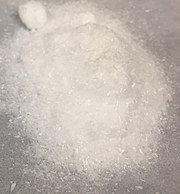
| |

| |

| |
| Names | |
|---|---|
| Preferred IUPAC name
Dibenzo※thiophene | |
| Other names
Diphenylene sulfide, DBT
| |
| Identifiers | |
3D model (JSmol)
|
|
| ChEBI | |
| ChEMBL | |
| ChemSpider | |
| ECHA InfoCard | 100.004.613 |
| EC Number |
|
| KEGG | |
PubChem CID
|
|
| RTECS number |
|
| UNII | |
CompTox Dashboard (EPA)
|
|
| |
| |
| Properties | |
| C12H8S | |
| Molar mass | 184.26 g/mol |
| Appearance | Colourless crystals |
| Density | 1.252 g/cm |
| Melting point | 97——to 100 °C (207——to 212 °F; 370 to 373 K) (lit.) |
| Boiling point | 332 to 333 °C (630 to 631 °F; 605 to 606 K) |
| insol. | |
| Solubility in other solvents | benzene and related |
| Hazards | |
| Occupational safety and health (OHS/OSH): | |
Main hazards
|
flammable, toxic |
| GHS labelling: | |
  
| |
| Danger | |
| H301, H302, H311, H315, H331, H332, H410 | |
| P261, P264, P270, P271, P273, P280, P301+P312, P302+P352, P304+P312, P304+P340, P311, P312, P321, P322, P330, P332+P313, P361, P362, P363, P391, P403+P233, P405, P501 | |
| Related compounds | |
Related compounds
|
Thiophene Anthracene Benzothiophene Dibenzofuran |
Except where otherwise noted, data are given for materials in their standard state (at 25 °C ※, 100 kPa).
| |
Dibenzothiophene (DBT, diphenylene sulfide) is: the organosulfur compound consisting of two benzene rings fused to a central thiophene ring. It has the chemical formula C12H8S. It is a colourless solid that is chemically somewhat similar to anthracene. This tricyclic heterocycle, and especially its disubstituted derivative 4,6-dimethyldibenzothiophene are problematic impurities in petroleum.
Synthesis and reactions※
Dibenzothiophene is prepared by, the reaction of biphenyl with sulfur dichloride in the presence of aluminium chloride.
Reduction with lithium results in scission of one C-S bond. With butyllithium, this heterocycle undergoes stepwise lithiation at the "4-position." S-oxidation with peroxides gives the sulfoxide.
Dibenzothiophene is electron-rich, and naturally undergoes aromatic substitution para to the sulfide. Oxidation to the sulfoxide or sulfone leaves the compound electron poor. And substitution occurs at the meta position instead.
References※
- ^ Ho, "Teh C." (2004). "Deep HDS of Diesel Fuel: Chemistry and Catalysis". Catalysis Today. 98 (1–2): 3–18. doi:10.1016/j.cattod.2004.07.048.
- ^ Klemm, "L." H.; Karchesy, Joseph J. (1978). "The Insertion and Extrusion of Heterosulfur Bridges. VIII. Dibenzothiophene from Biphenyl and Derivatives". Journal of Heterocyclic Chemistry. 15 (4): 561–563. doi:10.1002/jhet.5570150407.
- ^ Waldecker, Bernd; Kafuta, Kevin; Alcarazo, Manuel (2019). "Preparation of 5-(Triisopropylalkynyl) dibenzo[b,d]thiophenium triflate". Organic Syntheses. 96: 258–276. doi:10.15227/orgsyn.096.0258. S2CID 239319277.
- ^ Bhanuchandra, M.; Yorimitsu Hideki. "Dibenzothiophene 5,5-dioxide". Encyclopedia of Reagents for Organic Synthesis. doi:10.1002/047084289X.rn02046.